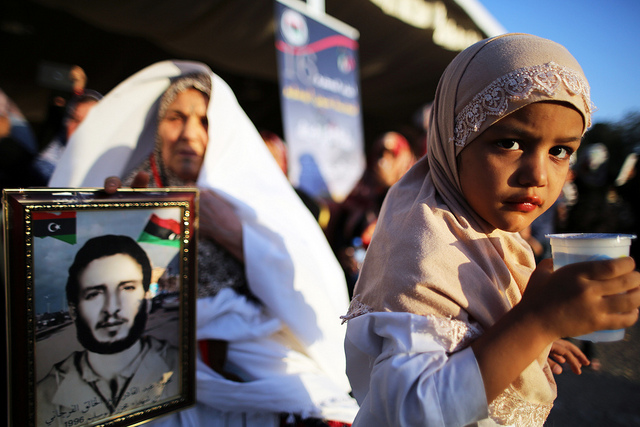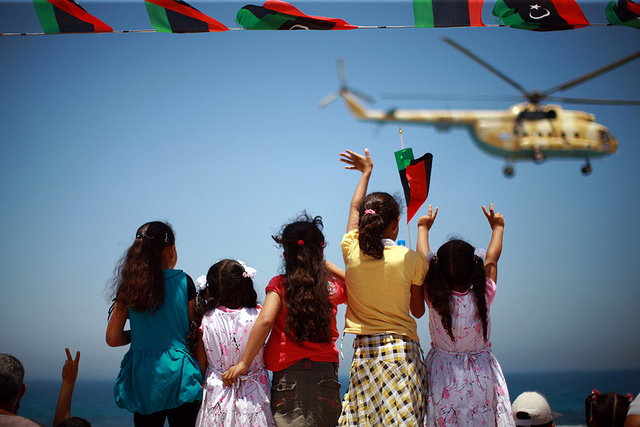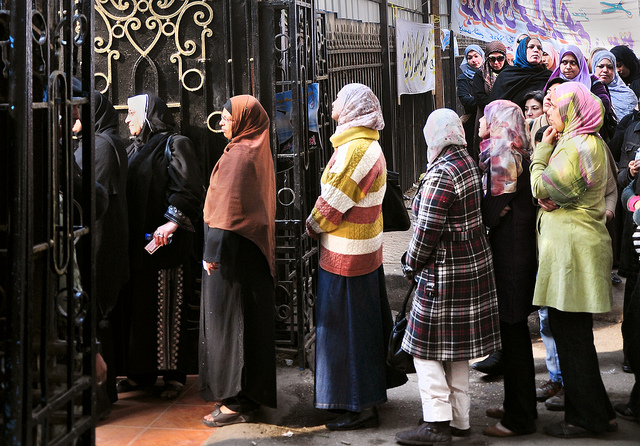Women, girls and the Arab spring
Dr Nicola Pratt, Politics and International Studies
Published June 2013
Are Arab women “the victims of eternal Arab-Islamic patriarchy”? Despite their heavy involvement in the 'Arab Spring', are they facing a “rollback [of] their rights and under-representation in emerging political institutions?” Dr Nicola Pratt, joint editor of Women and War in the Middle East, looks at the West’s portrayal of the Arab Spring, and its consequences, with a focus on the women involved in, and affected by, the uprisings.
 In Western media and policy forums, discussions of gender in the Arab Spring generally highlight what is considered to be a paradox: women have participated in large numbers in the uprisings across the Middle East but they face a rollback in their rights and under-representation in emerging political institutions. There are two intersecting discourses that construct this so-called paradox. First, a Euro-centric feminist framework, based on an idealised representation of the development of European women’s movements, whereby women’s public mobilization led directly to advancements in women’s rights and representation. The second discursive frame is a neo-orientalist one in which Arab women are the victims of eternal Arab-Islamic patriarchy.
In Western media and policy forums, discussions of gender in the Arab Spring generally highlight what is considered to be a paradox: women have participated in large numbers in the uprisings across the Middle East but they face a rollback in their rights and under-representation in emerging political institutions. There are two intersecting discourses that construct this so-called paradox. First, a Euro-centric feminist framework, based on an idealised representation of the development of European women’s movements, whereby women’s public mobilization led directly to advancements in women’s rights and representation. The second discursive frame is a neo-orientalist one in which Arab women are the victims of eternal Arab-Islamic patriarchy.
The two frames intersect to construct this paradox in Western media and policymaking circles.
The consequences of creating this apparent paradox include: homogenizing the experiences of women across the region; erasing the (geo-)political and socio-economic reasons why challenges to women’s rights exist in specific contexts; victimising Arab women and demonizing all Arab men; conflating all women’s agency with ‘feminist desires’; and revalidating the dictatorships that were deposed.
Both before and since the beginnings of the uprisings, mass protests and resistance activities, different women have had different experiences. The overriding characteristic of the Arab Spring is a popular rejection of the political status quo. However, this has been experienced differently across the region. Tunisia, Egypt and Libya are representative of countries where mass protests and, in the case of Libya, armed struggle, led to regime change. In Morocco, Yemen and, to some degree, Jordan, mass protests have led to various reforms of the existing regime. Other Arab countries have all experienced mass protests to different degrees, as well as armed struggle in the case of Syria, but without leading to any significant political transformations (yet).
Amongst these different groups of countries, it is very difficult to find a common pattern with regard to women’s rights. In Egypt, there has certainly been a clear challenge posed to existing measures that support women’s rights and equality by the lack of constitutional protection for equality in the revised constitution. Yet, various women’s initiatives continue to flourish since Mubarak was deposed. In Tunisia, women activists worry about defending the rights they enjoyed since independence, particularly in light of the rise in Salafism. However, until now, Ennahda has guaranteed to respect women’s existing gains. In Libya, women have achieved new levels of representation in government and parliament.
However, continuing lawlessness threatens women’s public participation. Women within countries have also had different experiences, based on their class, religion, place of residence (urban vs rural, capital vs province) as well as their attitudes towards the previous regime. What is perhaps clear from the series of elections that have taken place in Egypt since March 2011, is that there remains a significant number of men and women who continue to be disenfranchised from politics.
Anti-colonial
 A lot of excellent scholarship on gender in the Middle East demonstrates how gender roles, gender relations and gender ideologies have evolved in the relation to different (geo-)political and socio-economic processes, including colonialism, anti-colonial struggles, occupations, dispossessions, resistance, state-building and modernization strategies and the rise and fall of secular ideologies. This scholarship debunks the idea of ‘eternal Arab-Muslim patriarchy’ as well as illustrating the particular historical relationship between states and women’s movements.
A lot of excellent scholarship on gender in the Middle East demonstrates how gender roles, gender relations and gender ideologies have evolved in the relation to different (geo-)political and socio-economic processes, including colonialism, anti-colonial struggles, occupations, dispossessions, resistance, state-building and modernization strategies and the rise and fall of secular ideologies. This scholarship debunks the idea of ‘eternal Arab-Muslim patriarchy’ as well as illustrating the particular historical relationship between states and women’s movements.
The current transformations, transitions and popular demands for change are occurring in historical contexts that are particular to each country, although there are some shared cross-regional dynamics that are significant: the weakening of secular political projects, within which women’s rights projects were embedded, and the growth of Islamist movements, with different conceptions of ‘ideal’ gender relations, over the past 40 years; the intensification of neoliberal economic reforms, which have largely dismantled ‘ideal’ gender relations for working and lower middle class families but at the expense of the sustainability of social reproduction, thereby creating nostalgia for ‘traditional’ gender relations; the securitization of authoritarian regimes (that is, the increasing reliance by regimes upon coercion), often provoking feelings of emasculation amongst the victims of security forces.
In addition, in Egypt and Tunisia, state feminism is associated with the deposed dictatorships, thereby tarnishing women’s rights by association. Against this backdrop, we should not be surprised that women’s rights are being challenged, nor that conservative notions of gender relations resonate with large numbers of people.
In line with Orientalist tropes, the discourse of paradox victimizes Arab women, demonizes Arab men and opens the way for the West to ‘rescue’ the Arab world from its ‘uncivilized’ status. Since 9/11, women’s rights as an issue has become instrumentalised in Western foreign policy, particularly in the US, to demarcate ‘them’ from ‘us’ in the ‘war on terror’. It has become part of a racializing discourse that justifies wars, invasions and violence against Muslim men. Discussion of the fate of ‘women’s rights’ in the Arab Spring cannot be separated from this geopolitical context.
Yet, the Arab Spring has demonstrated that women are not passive victims of Arab-Muslim patriarchy. Not only have women been present in large numbers in the mass protests and uprisings across the region and also played diverse roles, including feeding fighters on the frontlines, working in field hospitals, smuggling medicines and monitoring human rights violations. In many cases, the Arab Spring is an accumulation of years of protest and dissent, in which women were also present. Women have been struggling for the same freedoms and social justice as men and they recognise that this is an ongoing struggle that has not ended with the fall of particular dictators or the introduction of new constitutions.
Despite the challenges presented by the current transitions and upheavals, women are continuing to mobilize and to resist. The case of Samira Ibrahim, who was subjected to sexual abuse at the hands of the Egyptian military police, and thousands of Egyptian women who have protested against violence against women, illustrate women’s perseverance, commitment and courage. I am not denying that some women have been victims of violence and abuse since the uprisings began, and, that violence against women has been a strategy used by Mubarak’s security forces and police, the Supreme Council of the Armed Forces and, more recently, by the Muslim Brotherhood to undermine the opposition. Rather, I want to highlight how women have reinscribed their victimisation as agency, in order to continue to resist political repression.
 Discourses about women’s rights after the Arab Spring assume that there is a consensus over what constitutes ‘women’s rights’ in the Arab World. Here, I do not wish to invoke cultural relativist arguments about the significance of women’s rights to different cultures. I recognise that debates over women’s rights have a long history in the region and that women’s movements have not imported a foreign ideology but have rooted their demands in the needs of their societies.
Discourses about women’s rights after the Arab Spring assume that there is a consensus over what constitutes ‘women’s rights’ in the Arab World. Here, I do not wish to invoke cultural relativist arguments about the significance of women’s rights to different cultures. I recognise that debates over women’s rights have a long history in the region and that women’s movements have not imported a foreign ideology but have rooted their demands in the needs of their societies.
Despite this history, women’s rights has become an increasingly contested term in light of the growth of Islamist movements, on the one hand, and the NGO-ization of Arab women’s movements, to use Islah Jad’s term, on the other hand, which has led to the de-politicization of women’s rights and its de-linking from national politics. This enables the Islamist discourse on gender to present itself as the only ‘authentic’ discourse.
The flourishing of political parties and social movements since the onset of the Arab Spring presents a new opportunity to articulate an alternative discourse about women’s rights that is progressive and rooted in local context. Yet, simultaneously, it is necessary to recognize and to directly address the obstacles to feminist/women’s rights projects in the current moment (i.e. the (geo-)political and socio-economic processes noted above). A narrow focus on women’s constitutional and legal rights alone will not be sufficient to reinvigorate Arab feminism.
Reforms
Possibly the worst consequence of the discourse of paradox is to implicitly revalidate the dictatorships that so many women and men struggled to overturn. There are several reasons why some dictators supported reforms that purported to be in the interests of women. In reality, they were nothing to do with the welfare and dignity of women but were rather part of regime strategies to provide legitimacy at home and abroad. For example, the women’s quota in parliament, introduced by Mubarak in 2009, merely added extra seats rather than allocating a percentage of existing seats to elected women. Moreover, given that elections were rigged in favour of the ruling party, the quota operated to increase the number of MPs for the ruling party in parliament whilst providing a ‘democratic’ façade to the international community.
The changes to divorce legislation in 2000 (khul’) (advocated by a coalition of women’s groups) were criticised not only by conservatives, who believed that they would undermine the patriarchal family, but also by some women activists/human rights defenders who saw the reforms as only applicable to those women who are sufficiently wealthy to be able to give up their economic rights in marriage. Moreover, the reforms did nothing to change the situation of Coptic Christian women, who are unable to seek a divorce. In Tunisia, the introduction of a relatively progressive Personal Status Code by Bourguiba was directly tied to his state-building and modernization strategy. Unsurprisingly, those who have not benefitted from the modernization of the Tunisian economy, have not benefitted from these rights bestowed upon women by the Tunisian state.
Moreover, women are not only defined by their gender. Class, religious affiliation, place of residence and/or ethnicity all play a role in shaping women’s experiences, such as, access to the workplace, access to justice, living environment, and access to services. For many women, their rights are linked to their dignity as human beings as well as the dignity of their families. This dignity has been actively undermined by dictatorial regimes. Which is why so many women have participated in the Arab Spring and why the discourse of paradox does not ring true.
This article was originally published in the newsletter of the Association of Middle East Women’s Studies and is republished with the permission of the author.
 Dr Nicola Pratt joined Politics and International Studies at Warwick in July 2009. Before entering the world of academia, she lived and worked in Egypt, working for several years on projects concerning human rights and democratisation.
Dr Nicola Pratt joined Politics and International Studies at Warwick in July 2009. Before entering the world of academia, she lived and worked in Egypt, working for several years on projects concerning human rights and democratisation.
Images: Libyans Remember Prison Massacre under Qadhafi - The United Nations (via Flickr)
Zawiya, Libya, Celebrates One-Year Anniversary of Anti-Qadhafi Uprising - The United Nations (via Flickr)
Egyptian Women Continue to Call for Real Change and Opportunities to Shape the Future - UN Women (via Flickr)
